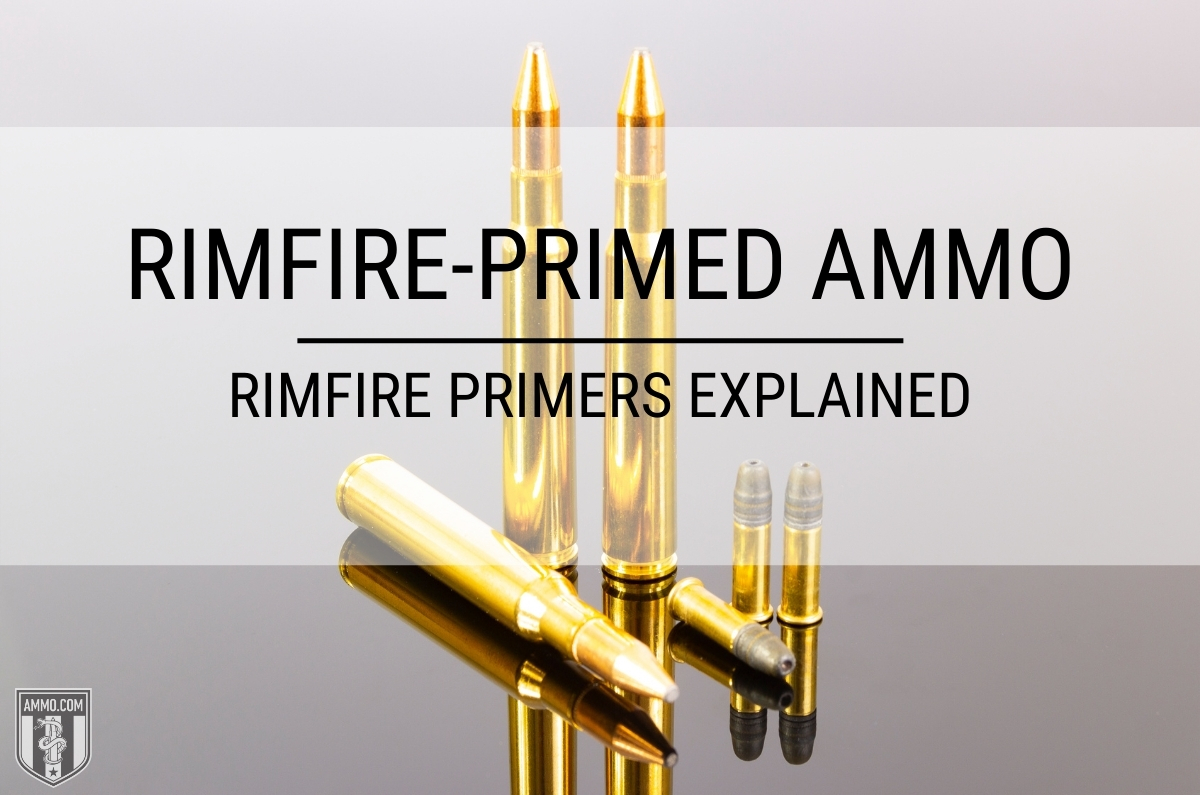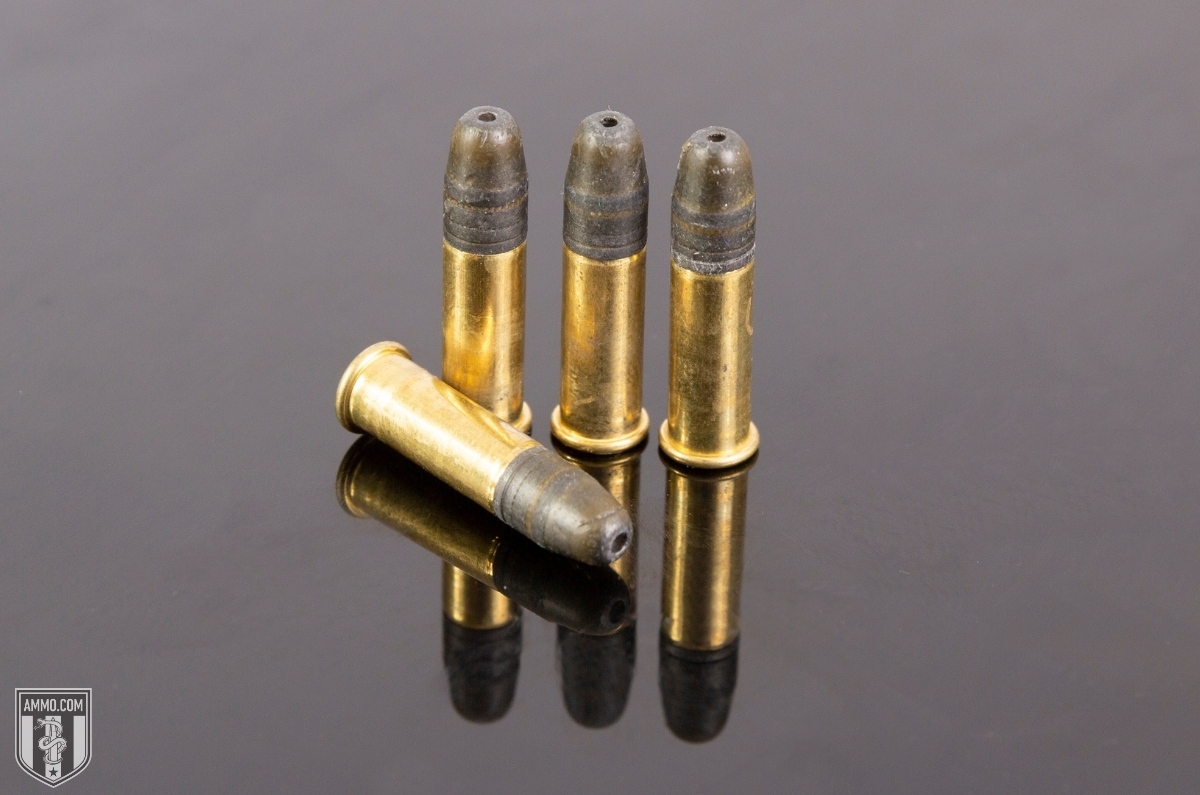Rimfire-Primed Ammo: Rimfire Primers Explained
 Rimfire is a category of ammunition that is fired when the firing pin strikes the rim of the cartridge. The primer compound is located inside the rim of the cartridge, hence the term “rimfire”.
Rimfire is a category of ammunition that is fired when the firing pin strikes the rim of the cartridge. The primer compound is located inside the rim of the cartridge, hence the term “rimfire”.
Rimfire ammo is the most common type of ammunition in the world today. It offers shooters a low pressure, low bullet weight, low recoil, and most importantly, low cost of entry into shooting. Additionally, it is extremely popular with new and young shooters.
Rimfire Ammunition: What is Rimfire Ammo?
Rimfire ammo is a type of metallic cartridge that is fired when the firing pin strikes the rim of the cartridge. Inside the cartridge case, the primer compound is spread evenly around the inside of the rim of the cartridge, which allows the firing pin to strike any location around the rim.
The pressure created by the firing pin strike ignites the primer in the rim of the cartridge. This ignites the propellant, which can be either black powder or smokeless powder. The pressure caused by the ignition of the propellant then pushes the bullet out of the barrel of the gun.
You can easily purchase a handgun or long gun chambered in rimfire – both semi-auto and bolt-action variants are available. Major firearms manufacturers like Smith & Wesson, Winchester, Ruger, Springfield, and Remington all carry at least one rimfire rifle, carbine, or handgun in their catalog.
Rimfire cartridges are the most popular ammunition in the world. They are available from a variety of manufacturers including Aguila, CCI, Winchester, Hornady, and Remington.
Due to the popularity of rimfire ammo worldwide, a variety of different cartridges are available to fit your needs for target shooting, plinking, and varmint control. These cartridges are readily available in hollow point and full metal jacket from most major ammunition manufacturers for plinking.
Rimfire shotshells are available to take care of small game at close range (snakes, rodents, etc.), while specialty match grade rimfire ammo is available for long range target shooting. Cost is another major benefit; compared to its centerfire counterpart, rimfire ammunition and firearms are considerably less expensive.
This makes rimfire an ideal choice for a rookie and seasoned shooter alike. As most rimfire cartridges are low pressure and have lower bullet weight, when compared to centerfire cartridges, the felt recoil is almost negligible. This allows new shooters to learn good shooting habits (trigger control, breath control, proper stance, etc.) without having to deal with uncomfortable recoil that can lead to bad shooting habits, like recoil anticipation and jerking the trigger.
The first rimfire cartridge was developed by the French gunsmith Louis-Nicolas Flobert in 1845. The cartridge he created was referred to as the 6mm Flober or the .22 BB Cap. It consisted of a percussion cap and a bullet without any additional propellant. All other rimfire cartridges after 1845 evolved from the .22 BB Cap.
Rimfire Calibers: What Calibers are Rimfire?
Historic rimfire cartridges have been available in multiple calibers from .17 caliber to .58 caliber; however, the heavier bullet weight cartridges were quickly replaced by centerfire cartridge cases to allow for added propellant, pressure, and increased reliability.
Modern rimfire ammunition is currently only available in .17 and .22 caliber.

.22 Short – This was developed by Smith & Wesson for their first revolver in 1857. Unlike the .22 BB Cap, the .22 Short utilized 4 grains (~260mg) of black powder as a propellant to fire a conical lead bullet. An older design, the .22 Short does not see much use in the 21st Century with the popularity of the .22 Long Rifle cartridge.
.22 Long – This was the natural progression from the .22 Short, and was introduced in 1871. The same bullet was used from the .22 Short but the case was elongated–it utilized 5 grains (~320 mg) of black powder. The .22 Long suffers the same deficiencies as the .22 Short in that it is inferior in design when compared to the more popular .22 LR.
.22 Long Rifle (.22 LR) – This cartridge was introduced in 1884 by the Union Metallic Cartridge Company and has since become the #1 rimfire cartridge sold worldwide. Using the .22 Long case and a longer bullet, the overall longer cartridge provided enhanced muzzle velocity and downrange ballistic performance. The introduction of the .22 LR made the .22 Long obsolete as it was simply an inferior cartridge in every aspect. The .22 Long Rifle has become the gold standard when it comes to rimfire cartridges and is available in multiple bullet configurations at a price point that cannot be beaten. With an effective range out to 150 yards with proper loadings, the .22 LR is the ideal choice for target shooters, plinkers, and varmint hunters. A .22 Long Rifle cartridge can achieve maximum velocities around 1640 ft/s at the muzzle.
.22 Winchester Magnum Rimfire (.22 WMR) – This cartridge was introduced by Winchester in 1959. The .22 WMR was designed to have a flatter trajectory and increased muzzle velocity when compared to the .22 LR. The .22 WMR was the only rimfire cartridge introduced in the 20th Century that is still in production today. As the .22 WMR shoots faster, flatter, and hits harder than the .22 LR, it is very popular with larger varmint and small game hunters. The .22 WMR can achieve maximum velocities of around 2,300 ft/s at the muzzle.
.17 Hornady Magnum Rimfire (.17 HMR) – This cartridge was developed by Hornady in 2002. Utilizing a .22 WMR case that has been necked down to accept a .17 caliber bullet, the .17 HMR can achieve velocities that exceed that of the .22 WMR parent cartridge. With proper loadings, .17 HMR can achieve a maximum velocity of around 2,650 ft/s at the muzzle, exceeding the maximum velocity of the .22 WMR by approximately 15%.
.17 Hornady Mach 2 (.17 HM2) – With the success of the .17 HMR, Hornady undertook the same procedure they performed on the .22 WMR with the .22 LR case instead. The .17 Hornady Mach 2 was introduced in 2004 and utilized a necked down .22 LR cartridge case to accept a .17 caliber 17 gr V-Max bullet. Although the .17 HM2 does not travel at speeds exceeding Mach 2, it does outpace the parent cartridge by achieving muzzle velocities around 2,100 ft/s. The .17 Hornady Mach 2’s popularity has arisen because .22 LR chambered firearms can be converted to .17 HM2 with a simple barrel swap.
.17 Winchester Super Magnum (.17 WSM) – Not to be outdone by Hornady, Winchester partnered with the Savage Arms Company to develop the .17 Winchester Super Magnum and introduced the cartridge at the 2013 SHOT Show. The .17 WSM utilizes a .27 caliber nail gun blank cartridge that can withstand pressures approximately 50% higher than the .17 HMR. With the increased case capacity and pressure limits, the .17 WSM can achieve a maximum velocity of 3,300 ft/s at the muzzle.

Final Thoughts
Rimfire ammunition and firearms are extremely popular with new and experienced shooters and provide a strong foundation for learning the fundamentals of shooting. With a wide variety of bullets, loadings, and applications, it will always have a place in the inventory of every shooter.
The flexibility of the cartridge design allows for a wide variety of applications, from long range target shooting to varmint control, with reduced cost per round when compared to their centerfire counterparts.
As ammo companies and wildcatters continue to push the limits of velocity with rimfire cartridges in a pseudo-nuclear arms velocity race, new applications might arise in the future.
That being said, there’s no doubt that every firearm owner needs to have at least one .22 LR firearm in their collection to learn proper shooting techniques and to pass down to the next generation of 2A supporters.
